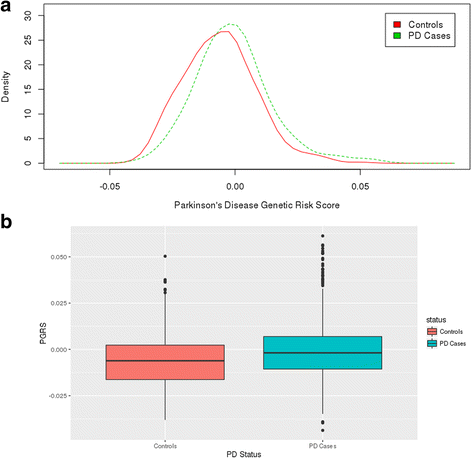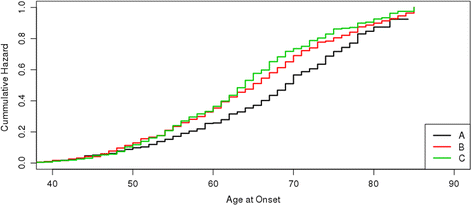Parkinson disease polygenic risk score is associated with Parkinson disease status and age at onset but not with alpha-synuclein cerebrospinal fluid levels
- PMID: 29141588
- PMCID: PMC5688622
- DOI: 10.1186/s12883-017-0978-z
Parkinson disease polygenic risk score is associated with Parkinson disease status and age at onset but not with alpha-synuclein cerebrospinal fluid levels
Abstract
Background: The genetic architecture of Parkinson's Disease (PD) is complex and not completely understood. Multiple genetic studies to date have identified multiple causal genes and risk loci. Nevertheless, most of the expected genetic heritability remains unexplained. Polygenic risk scores (PRS) may provide greater statistical power and inform about the genetic architecture of multiple phenotypes. The aim of this study was to test the association between PRS and PD risk, age at onset and cerebrospinal fluid (CSF) biomarkers (α-synuclein, Aβ1-42, t-tau and p-tau).
Methods: The weighted PRS was created using the genome-wide loci from Nalls et al., 2014 PD GWAs meta-analysis. The PRS was tested for association with PD status, age at onset and CSF biomarker levels in 829 cases and 432 controls of European ancestry.
Results: The PRS was associated with PD status (p = 5.83×10-08) and age at onset (p = 5.70×10-07). The CSF t-tau levels showed a nominal association with the PRS (p = 0.02). However, CSF α-synuclein, amyloid beta and phosphorylated tau were not found to be associated with the PRS.
Conclusion: Our study suggests that there is an overlap in the genetic architecture of PD risk and onset, although the different loci present different weights for those phenotypes. In our dataset we found a marginal association of the PRS with CSF t-tau but not with α-synuclein CSF levels, suggesting that the genetic architecture for the CSF biomarker levels is different from that of PD risk.
Keywords: Age at onset; Biomarkers; Genetics; Parkinson disease; Polygenic risk score.
Conflict of interest statement
Ethics approval and consent to participate
Written informed consent was obtained from all participants prior to their enrolment. This study was approved by the Washington University in Saint Louis Institutional Review Board and the Human Research Protection Office (approval number: 201107095).
Consent for publication
Not applicable – this manuscript does not contain any individual person’s data.
Competing interests
The authors declare that they have no competing interests.
Publisher’s Note
Springer Nature remains neutral with regard to jurisdictional claims in published maps and institutional affiliations.
Figures


References
MeSH terms
Substances
Grants and funding
LinkOut - more resources
Full Text Sources
Other Literature Sources
Medical

